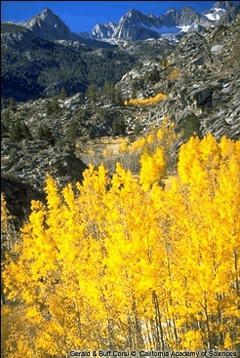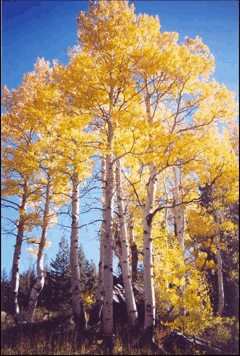Vanishing Aspens
Air Date: Week of September 25, 2009

A stand of Aspen trees in California (Courtesy of the California Department of Fish and Game)
Scientists report that drought conditions in the Rocky Mountain West are contributing to SAD, Sudden Aspen Decline.
Transcript
YOUNG: Fall is upon us. And for the Rocky Mountain West that means the beautiful gold colors of the aspens. But, increasingly, the aspens are dying. Jim Worrall is a US forest service plant pathologist studying whatÂ’s called Sudden Aspen Decline, with the fitting acronym, SAD. Mr. Worrall, this really is a sad phenomenon, isnÂ’t it?
WORRALL: Yes it is, a lot of people are very concerned about it, and we certainly are, too.
YOUNG: Well, give me a sense of the scale. How big an area is being affected here.
WORRALL: It now occupies about 17 percent of the aspen cover type, or the aspen forest type, within Colorado. It extends up into southern Wyoming, and in northern Arizona and southern Utah, thereÂ’s very similar damage that started a little bit earlier.
YOUNG: What’s going on – why is this happening?
WORRALL: It’s a complex cause – the main inciting factor that we believe is responsible is the major extreme drought we had earlier in the decade. It was very dry during that time and most importantly, it was extremely hot, record-breaking temperatures during that period, so it’s a little bit of a delayed effect from the drought.
YOUNG: When you talk about drought being a factor here, one of the things that pops into my mind is the projections about the increased likelihood of drought in the West. How does climate change relate to this?

(Courtesy of M. Dupper)
WORRALL: We expect that will lead to a recurrence and probably a worsening of Sudden Aspen Decline. There have also been projections of where aspen is expected to be lost in the early stages of climate change during this century, and itÂ’s been shown that those are areas where we are losing aspen as a result of Sudden Aspen Decline, so itÂ’s not too big a stretch to suggest that Sudden Aspen Decline is the early effects of climate change.
YOUNG: As I understand it, aspen stands – they’re really kind of the same tree, all connected under the soil, right?
WORRALL: ThatÂ’s right. Aspen is a clonal plant, most of the regeneration, most of the stems you see in an aspen stand arose as sprouts or suckers from the roots of a previous aspen tree, and thatÂ’s an important factor in understanding how aspen regenerates, typically.
One of the major problems with the Sudden Aspen Decline is that although the over-stories are dying, the roots donÂ’t seem to be producing suckers to the extent you would hope and that they normally would be if there was a disturbance like a fire or cutting. So, there is concern that some of these aspen stands might not replace themselves.
YOUNG: So, if they donÂ’t replace themselves, will these areas be replaced by other trees, and that isnÂ’t that just kind of the natural succession of the forest?
WORRALL: Yes, I guess that is a successional process, but it means more or less very long-term, semi-permanent loss of aspens on a lot of these sites, which a lot of people donÂ’t want to see.
YOUNG: So, what can you do about this?

A stand of Aspen trees in California (Courtesy of the California Department of Fish and Game)
WORRALL: Well, one thing we can do, we could take action to disturb them in a way that aspen responds to disturbance by producing a lot of sprouts, a new stand, and give them the best chance they have of regenerating before they completely lose all their energy and die out. But, uh, another thing in the long-term is to encourage age diversity in the forest, especially the aspen forest because we know that young stands that had been, say where there’d been cuts or fires 20, 30, 40 years ago – those young stands that have sprouted up to replace the old stands have basically not been affected by Sudden Aspen Decline.
YOUNG: Fire always a big concern in the West. Is this going to add to the potential for fires, having those dead standing trees?
WORRALL: In the short-term, that’s not likely because aspen forests are not very flammable, they hold a lot of moisture and when a fire comes up to an aspen forest it generally slows down or stops. So, even after the over-stories are dead for quite awhile that feature will be retained. But in the long-term, as these stands convert to other forest types, we have conifers or sagebrush, for instance, we won’t have those aspen stands to stop fires as they’re going through the forest. And, so that could be a – over the very long-term – a factor to lead to increased fire spread.
YOUNG: Mr. Worrall, IÂ’m guessing youÂ’re a woodsman, you like to get out there and enjoy these forests. How has this affected the way you are able to relate to aspen forests and enjoy, especially, the fall season?
WORRALL: Well, I have to tell ya, itÂ’s really been great for me, because IÂ’ve been in aspen forests a lot more now, as a result of this.
YOUNG: (Laughs) This gives you an excuse to get out there more! Right, yeah.
WORRALL: Yeah, instead of conifer forests, and the aspen forests are, to me, they are much more beautiful and pleasant to work in.
YOUNG: (Laughs) But, itÂ’s gotta be kind of a bummer to be out among the dying stands?
WORRALL: ThatÂ’s true, it is kind of sad from that point of view. No pun intended.
YOUNG: Jim Worrall, a plant pathologist with the US Forest Service telling us about Sudden Aspen Decline, thanks for your time.
WORRALL: Thank you.
Living on Earth wants to hear from you!
Living on Earth
62 Calef Highway, Suite 212
Lee, NH 03861
Telephone: 617-287-4121
E-mail: comments@loe.org
Newsletter [Click here]
Donate to Living on Earth!
Living on Earth is an independent media program and relies entirely on contributions from listeners and institutions supporting public service. Please donate now to preserve an independent environmental voice.
NewsletterLiving on Earth offers a weekly delivery of the show's rundown to your mailbox. Sign up for our newsletter today!
 Sailors For The Sea: Be the change you want to sea.
Sailors For The Sea: Be the change you want to sea.
 The Grantham Foundation for the Protection of the Environment: Committed to protecting and improving the health of the global environment.
The Grantham Foundation for the Protection of the Environment: Committed to protecting and improving the health of the global environment.
 Contribute to Living on Earth and receive, as our gift to you, an archival print of one of Mark Seth Lender's extraordinary wildlife photographs. Follow the link to see Mark's current collection of photographs.
Contribute to Living on Earth and receive, as our gift to you, an archival print of one of Mark Seth Lender's extraordinary wildlife photographs. Follow the link to see Mark's current collection of photographs.
 Buy a signed copy of Mark Seth Lender's book Smeagull the Seagull & support Living on Earth
Buy a signed copy of Mark Seth Lender's book Smeagull the Seagull & support Living on Earth

